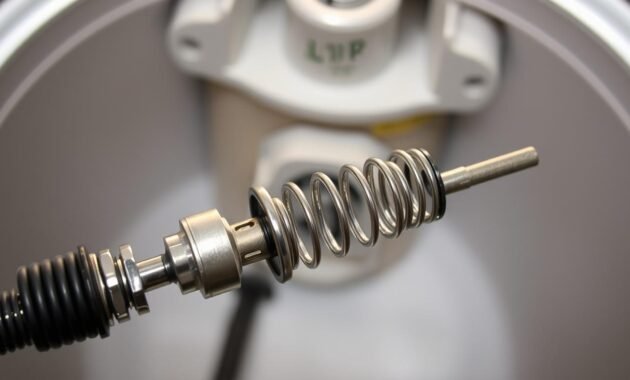Are you facing a frustrating water heater element failure? It seems like a massive repair project. Many homeowners dread the idea of draining their entire water tank for a simple element replacement.
The thought of complex plumbing work and a water mess can be overwhelming. I’ll reveal a game-changing technique for replacing water heater elements without draining the tank. This method can save you hours of work and reduce the complexity of your repair.
By following my step-by-step guide on how to replace water heater element without draining, you’ll tackle this repair confidently and efficiently. Get ready to transform a potentially stressful repair into a manageable DIY project. This will keep your hot water flowing with minimal disruption.

Read also: How to Scrap a Water Heater?
Understanding Your Water Heater Element System
Knowing your water heater element system is key to saving time, money, and stress. I’ll explain the important parts that keep your hot water flowing well.
Water heater elements are the heroes of your home’s hot water. They work hard to heat water in your tank, making it warm and cozy for you.
Types of Water Heater Elements
- Screw-in elements: Most common in residential water heaters
- Flange elements: Typically used in larger commercial tanks
- Copper elements: Known for durability and efficient heat transfer
- Stainless steel elements: Resistant to mineral buildup
Common Signs of Element Failure
Testing your water heater elements is key when you see these signs:
- Lukewarm or inconsistent water temperature
- Strange noises coming from the water heater
- Reduced hot water volume
- Visible rust or corrosion on the element
How Elements Work in Your Tank
| Element Type | Heating Capacity | Typical Lifespan |
|---|---|---|
| Lower Element | 1000-4500 watts | 6-10 years |
| Upper Element | 1000-5500 watts | 5-8 years |
Knowing about your water heater’s elements helps you spot problems fast. Most have two elements, one at the top and one at the bottom. They heat water by using electrical resistance, turning electrical energy into heat.
Regular maintenance can make your elements last longer. By testing your elements often, you can find issues early and avoid expensive fixes.
Read also: How Much Does it Cost of Replacing a Water Heater
Essential Tools and Materials for Element Replacement
Getting ready for a tank water heater element replacement means you need the right tools and materials. I’ll show you what you need to do a successful DIY water heater repair.
First, you’ll need a special toolkit for this job. Here’s a list to help you get started:
- Water heater element wrench (specifically designed for removing heating elements)
- Multimeter for electrical testing
- Phillips and flathead screwdrivers
- Garden hose for possible drainage
- Safety gloves and protective eyewear
For materials, you’ll need to buy:
- New heating element that fits your water heater
- Replacement rubber gasket
- Teflon tape for sealing connections
- Electrical continuity tester
Make sure to check your water heater’s manual or model number. This ensures you get the right element. Some hardware stores can help you find the right part if you show them your old element.
Pro tip for DIY water heater repair: Always get a spare gasket. These small rubber seals are key to avoiding leaks and can easily get damaged during removal.
Safety First: Preparing Your Water Heater
Fixing your water heater at home needs careful steps and safety first. Before you start, knowing the right safety rules is key. It helps avoid electrical dangers and keeps you safe.
Dealing with electrical items is very dangerous. I’ll show you how to stay safe while fixing your water heater.
Power Disconnection Steps
Turning off the power is your first safety step. Here’s how to do it:
- Find your home’s electrical panel
- Find the circuit breaker for the water heater
- Switch the breaker to the “OFF” position
- Check if the power is off with a voltage tester
Testing for Live Circuits
Always test a circuit before assuming it’s off. Use a good multimeter to check for live electricity. This is very important to avoid getting shocked while fixing your water heater.
Water Supply Management
Managing your water supply is also key when fixing your water heater. Here’s how to handle it:
- Find the cold water inlet valve near your water heater
- Turn the valve clockwise to shut off water completely
- Open a hot water faucet to release pressure
- Make sure water flow has stopped
By following these safety steps, you’ll make a safe space for fixing your water heater. This way, you’ll avoid risks and make sure your repair goes well.
How to Replace Water Heater Element without Draining
Changing a water heater element without draining can save you time and mess. I’ll show you how to do it easily, with less water spillage.

Before you start, be ready for mineral sediment release. A successful no drain change needs good preparation and careful steps.
- Gather protective gear like rubber gloves and safety glasses
- Have towels and buckets ready for water spillage
- Ensure you have the correct replacement element
For an easy swap, follow these steps:
- Turn off power to the water heater at the circuit breaker
- Remove the access panel covering the heating element
- Use an element wrench to loosen the old element
- Slowly extract the element, allowing minimal water release
- Insert the new element, ensuring a tight seal
| Technique | Difficulty Level | Potential Mess |
|---|---|---|
| No Drain Replacement | Moderate | Low to Medium |
| Full Tank Drain | High | Minimal |
Pro tip: Keep a bucket nearby and move slowly to minimize water spillage. The process requires patience but can be accomplished with careful technique.
Dealing with Mineral Deposits and Sediment
Mineral deposits can really hurt your electric water heater’s performance. As a homeowner, it’s key to know how to handle these tough buildups. This is important for keeping your electric water heater in top shape.
When you check your water heater, you often find sediment is the main problem. These mineral deposits can cause big issues for your water heating system.
Understanding Mineral Buildup Sources
- Hard water containing calcium and magnesium
- High mineral content in local water supply
- Aging water heater tank
- Lack of regular maintenance
Effective Cleaning Techniques
To fight mineral deposits, a clean and organized approach is best. Here are some effective cleaning methods:
- Flush the tank annually to remove sediment
- Use a water softener to reduce mineral buildup
- Install a sediment filter in your water line
- Check the elements regularly
Regular upkeep can make your water heater last longer and work better. By tackling mineral deposits early, you’ll avoid costly fixes and keep your hot water flowing smoothly.
Installing the New Heating Element Properly
When you replace the tank water heater element, being precise is very important. I’ll show you how to install your new heating element correctly and confidently.
Read also: Water Heater Strap Code and Guide to Strap Your Tank Unit Properly
Before you start, make sure you have the right element for your water heater. It’s key to fit it right, even if you don’t drain the tank.
- Position the new gasket carefully to create a watertight seal
- Align the element precisely with the tank opening
- Start threading the element by hand to prevent cross-threading
- Use a specialized water heater element wrench for final tightening
How you tighten the element is very important. Start by tightening it by hand. Then, use a wrench to tighten it a bit more. But don’t overdo it, as it can damage the gasket or the element.
| Installation Step | Key Considerations |
|---|---|
| Gasket Placement | Ensure complete coverage, no gaps or misalignment |
| Element Positioning | Align straight, avoid angular insertion |
| Tightening Pressure | Firm but not excessive – prevent damage |
Be careful during installation. The heating element should fit perfectly against the tank wall. The gasket should seal well to avoid leaks.
Read also: How to Check Water Heater Element
Testing Your Newly Installed Element
After fixing your water heater, it’s important to test it well. Testing the water heater element needs careful steps to make sure it’s working right.
After installing, you need to check a few key things. This makes sure your heating element works well and safely.
Leak Check Process
First, do a leak check right after you install. Look at these spots:
- Check the element connections
- Make sure the gasket and seal are good
- Look for any leaks around the element
- Use a flashlight to check if connections are tight
Performance Verification
Testing your water heater element takes time and careful steps. Let it heat water for 1-2 hours before you start testing.
| Test Parameter | Expected Outcome |
|---|---|
| Water Temperature | Heats water to the right setting |
| Recovery Rate | Heats water fast, in 30-45 minutes |
| Electrical Continuity | Has a stable electrical connection |
Temperature Setting Adjustment
Adjusting your water heater’s temperature is key. Use the thermostat to set it between 120-140 degrees Fahrenheit. This is for the best performance and safety.
- Find the thermostat dial
- Adjust it to your preferred temperature
- Wait 24 hours to see if it stays consistent
- Use a thermometer to check the water temperature
By doing these tests, you’ll know your water heater element replacement was a success. It will also last longer.
Troubleshooting Common Installation Problems

Fixing a water heater element yourself can be tricky. Even with good planning, you might face unexpected problems during installation.
Here are some common issues that can make fixing your water heater hard:
- Persistent leaks around the heating element connection
- Electrical continuity problems
- Unexpected resistance when installing new elements
- Mineral buildup blocking proper installation
If you notice leaks, stop right away and think about it. Look at the gasket and element threads closely. A bad gasket can cause leaks, so replace it if it’s damaged.
Electrical issues need careful checking. Use a multimeter to check the new element’s continuity before you install it. If you find resistance or the element doesn’t fit right, check your water heater model’s specs again.
- Verify element size and wattage match your specific water heater
- Inspect threads for any damage or corrosion
- Clean the mounting area thoroughly before reinstallation
If you’re not sure about any part of the troubleshooting, it’s okay to ask for help. Some repairs are safer and better done by professionals.
Maintenance Tips to Extend Element Life
Keeping your electric water heater in good shape is key for its long-term performance. Maintenance isn’t just about fixing issues; it’s about stopping them before they happen. Here are my best tips for keeping your water heater elements working well.
Regular upkeep can make your water heater elements last longer. An easy swap becomes less common when you follow these important steps:
- Check the anode rod for corrosion every year
- Flush the tank every six months to clear sediment
- Look for wear on electrical connections
- Watch the water pressure to avoid stressing the elements
Creating Your Inspection Routine
It’s smart to set up a regular maintenance schedule. Mark your calendar for quarterly checks. During these inspections, look for:
- Rust or corrosion around connections
- Water that’s not its usual color
- Strange noises from the tank
- Less hot water than usual
Preventive Protection Strategies
Protecting your water heater elements is simple. If you have hard water, get a water softener. Soft water stops mineral buildup that harms heating elements. Also, keep the area around your water heater clean to ensure it works best.
By spending a bit of time on maintenance, you’ll save money on repairs. Plus, you’ll have hot water consistently for many years.
Conclusion
Replacing a water heater element without draining can save you time and effort. I’ve shown you how to remove a rusted element and install a new one safely. It’s important to know your water heater’s specific needs for successful maintenance.
When deciding to replace the element, check your water heater’s condition. Older units might need more repairs or a full replacement. Look at the element’s damage, corrosion, and compare repair costs to a new installation.
It’s wise to maintain your water heater regularly. Early inspections can prevent big problems and costly repairs. With this guide, you’ll be ready to tackle most element issues confidently.
Read also: The Capacity Of A Water Heater Is Measured In What ?
While DIY repairs are rewarding, seek a professional plumber for complex issues. Your safety and the water heater’s proper function are key.


